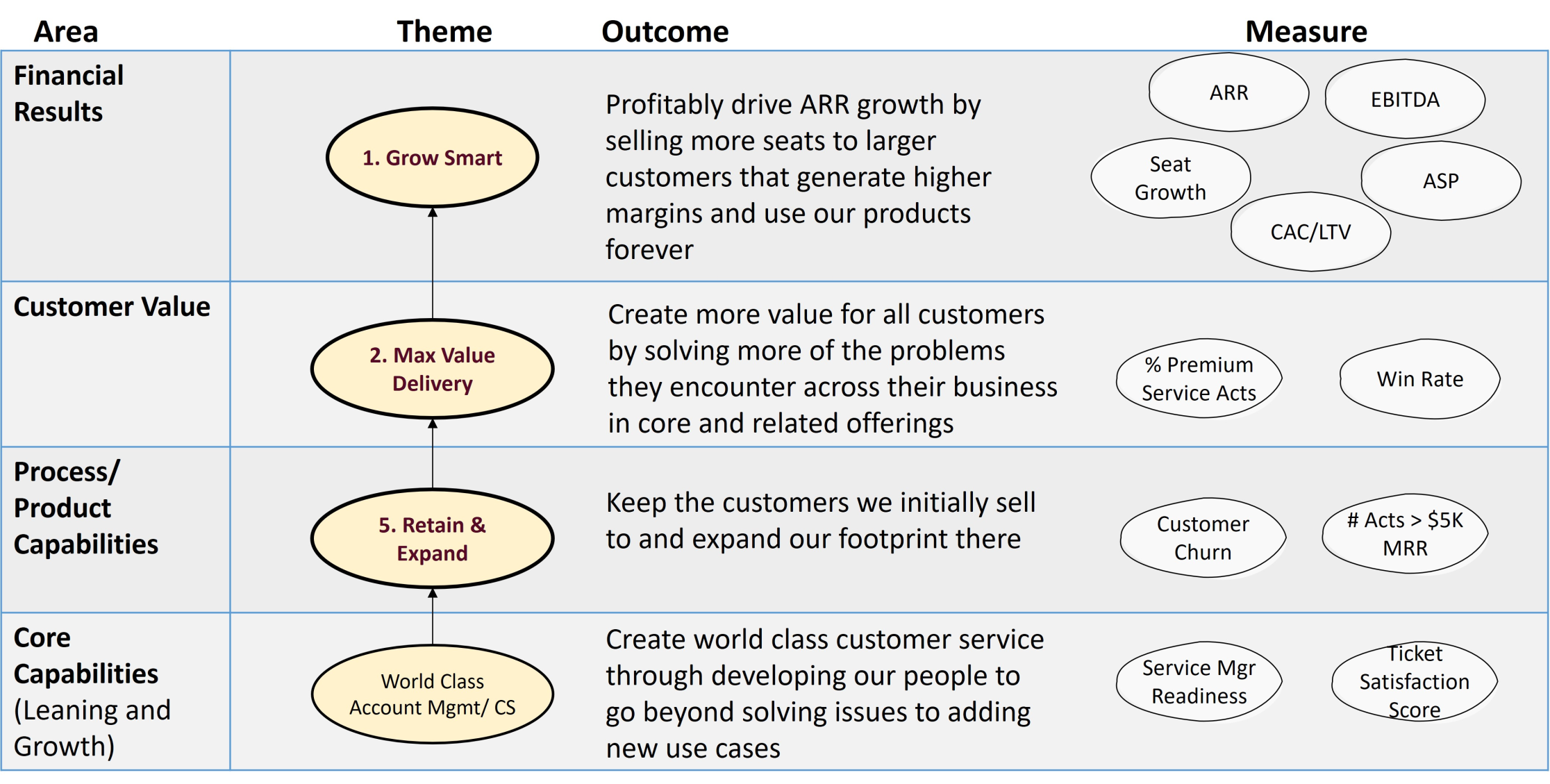Creating the right business measures allows companies to translate their Positioning/vision and Strategy into actionable goals. I’ve written before about creating a scorecard for your business. This article elaborates on why the right measures are critical to success and outlines the steps for creating your own scorecard with the right measures to powerfully drive success.
Why Keep Score?
Scorecards are not a just a list of Measures that you think are important. Done correctly, they:
- Clarify Vision and Strategy: Ensure everyone is aligned by crystallizing the mission, vision, and strategic priorities (Themes) of the business to foster a unified understanding of vision and focused action across all levels of the business.
- Business Health: Create a quick, objective way to know whether current execution is delivering expected results, so you know whether additional focus from leadership is needed.
- Strategic Adaptability: Enable understanding of business progress to accelerate adaption to opportunities, changing market conditions, and emerging trends.
- Objective Decision Making: Identify trends, areas of needed improvement, and create other actionable insights that allow adding resources and fixing issues to accelerate success.
- Communication and Alignment: Serve as a common language to ensure that everyone knows how to translate strategy to execution with the right priorities, progress, and synergy.
- Performance Evaluation and Accountability: Foster a culture of accountability and continuous improvement and offer an objective, transparent way to reward good performance.
How to Create Powerful Measures
The steps are:
- Clarify Business Positioning and Themes
- Identify possible Measures for each Theme
- Define each Measure
- Select the best for your scorecard
- Set good Target goals
- Track and tune progress at Leadership Team Meetings
- Integrate outcomes and refine
1: Creating good Measures for your scorecard starts with clarifying your business Positioning (Mission, Vision, and strategic Themes and Objectives. This clarity is crucial as it sets the foundation for the scorecard. The outcome of this exercise is your Shared Business Model captured on Your Vision Cheat Sheet including your strategic Themes. (see links for details)
2: Next, identify key Measures (Some call these KPIs or key results) that align with the strategic Themes. These Measures demonstrate how effective the company is at achieving key business Outcomes related to the Themes that deliver your strategy and vision.
For each Theme, give at least one descriptive Outcome and objective Measure that will indicate reaching the destination. This process helps make the Theme more concrete and allows the right focus of resources to reach the Theme. Themes’ Outcomes may be less tangible than specific measures in your strategic planning horizon. But it should always be possible to determine whether you are making progress and whether the Theme is eventually achieved or not.

Work your way up a strategy map from each core capability to create one or two Measures that can track whether you are making progress toward delivering the objective of that Theme. This bottoms up approach helps to identify leading and diagnostic indicators for your strategy. As you work up from additional Themes, you should find that fewer and fewer new metrics are added toward the top.
3: To ensure usefulness and shared understanding of each Measure, make their definition explicit. Spell out the following attributes for any proposed Measure:
- Name
- How it supports a strategic Theme
- Definition with formula and source of data
- Frequency of reporting
- Who will use it and the value they expect
- Who will collect data and report it
- The cost to produce it
- Any potential unintended consequences from its use
4: Once all Measures are defined, check to ensure it serves the intended purpose well and adds value beyond the cost and unintended consequences. Create a review process with your leadership team to ensure they will get value before adding any Measure. Keep it as simple as possible. Not every measure should make the cut and fewer measures are often more valuable.
5: Set Targets for each Measure to provide direction and benchmarks for success. Use the good goal setting approach to set and get agreement for TTS goals with a number for:
- Threshold (achievable with 85-90% confidence)
- Target (achievable about 50-60% of the time)
- Stretch (10-20% achievable)
6: After establishing these Targets, ensure that the scorecard is not just a measurement tool but also a management system that fosters continuous improvement. Create, update, and review your scorecard regularly. Reviewing them is an agenda item in your Leadership Team Meetings. Take actions that deliver your Targets:
- Create initiatives to drive goal achievement
- Identify and correct issues that are uncovered
- Review the why section above and take other actions to achieve those outcomes
7: Finally, periodically use a critical eye to adapt the scorecard to keep it relevant and aligned with the evolving business context. Raise issues any time you feel like a need is not being met. Your periodic strategy refresh meetings are a good time for these adaptations, especially if priorities or Themes change.
This outlines the why and how of creating a scorecard. The right metrics bridge the gap between strategy and execution, providing a roadmap for success. The scorecard becomes a living gage that guides the company’s strategic actions and decisions, ensuring that all efforts are aligned with the long-term vision of the business.
See related articles about: Envisioning Positioning, Vision Cheat Sheet, Creating Themes, Keeping Score, and Setting TTS Goals.
How will you ensure the Measures that track your business deliver powerful value?
Leave a comment to help others find this and subscribe if you found this article useful.
May you find Passion, Joy and Freedom in all your Adventures.